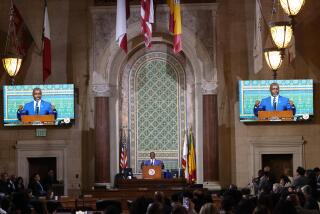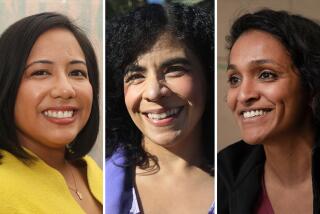First & Spring: Wesson agenda looks a lot like a mayor’s
Los Angeles City Council President Herb Wesson spent the last 10 days sounding a lot like a mayor.
Two weekends ago, Wesson promised to overhaul the city’s system of neighborhood councils, telling a roomful of community volunteers, “I will be your biggest cheerleader.” Four days later, he announced that city lawmakers would craft a plan for attracting jobs, news that was catnip to the city’s business leaders.
The next day, Wesson pitched his agenda to The Times editorial board, saying he wanted a city-sponsored conversation about race. Council members also will spend several months, he said, developing strategies to solve, not manage, homelessness — a problem that has vexed policymakers for decades.
“You have to aim high, and you have to have faith,” he said.
What all this means for the actual mayor, Eric Garcetti, is not entirely clear. Garcetti, who just reached the halfway mark in his four-year term, has taken a low-key, technocratic approach to his job, frequently shunning the spotlight while focusing on sensible fixes to city government. But Wesson’s expanding agenda has the potential to put Garcetti in an unflattering light, said Jaime Regalado, emeritus professor of political science at Cal State L.A.
“What it does is kind of undercut the mayor,” he said. “It almost makes it appear as if the mayor is standing still.”
Wesson spent much of last week insisting that his legislative plans, unveiled minutes after he was unanimously reelected president, should not reflect badly on the mayor. The council, he said, is ready for big challenges following its vote to hike the citywide minimum wage. Wesson pointed out that he has already endorsed Garcetti for reelection in 2017 and works closely with him.
“If you look at the history of relationships between mayors and council presidents, I think that the relationship we have with Eric would be right up there” with former Mayor Tom Bradley and former council President John Ferraro, who served together in the 1970s, ‘80s and ‘90s, Wesson said. “It’s a good, honest working relationship.”
Ferraro, it should be noted, did mount an unsuccessful challenge to Bradley in 1985.
Garcetti, for his part, is offering support for Wesson’s new initiatives, saying he looks forward to collaborating with him. Jeff Millman, Garcetti’s spokesman, said the mayor has spent two years pursuing his own list of policy goals: increasing the minimum wage; lowering the city’s business tax; improving earthquake preparedness; sending a rail line to Los Angeles International Airport; and providing body cameras to every officer in the Los Angeles Police Department, among other things.
“Mayor Garcetti’s bold agenda is to build a city that works, with common-sense reforms at City Hall, and more services, infrastructure and jobs for Angelenos,” Millman said in a statement.
Since taking office in 2013, Garcetti has adopted a considerably lower profile than his predecessor, Mayor Antonio Villaraigosa. He has held back on taking positions on issues in ways that Wesson has not.
Wesson pushed hard this year for passage of two ballot measures that changed the election date for city and school board elections. Garcetti, by contrast, remained noncommittal until the end, declining to say whether he favored the changes or not.
Garcetti, in typical fashion, did not stage a major public event to commemorate the halfway point in his term. Instead, he started the third year of his administration by attending a swearing-in ceremony for another elected official: newly installed Councilman Marqueece Harris-Dawson.
That same day, Wesson kicked off the council’s new legislative session in a splashier way. Using a booming voice normally reserved for political rallies, Wesson told his colleagues they would spend the next two years focusing on such hot-button issues as poverty, the drought, human trafficking, job creation, homelessness and even race relations.
Before wrapping up, Wesson prodded his colleagues to ignore their detractors and celebrate their accomplishments. Statues, he said, are built not for critics but for the leaders who are the targets of their complaints. “Let’s go out and let’s build some damn statues,” he declared.
Not everyone was convinced. One business owner, still stinging over the council’s recent decision to push the minimum wage to $15, called Wesson’s promise of an economic plan “political theater with no substance.”
“What he’s saying is, we’re going to come up with a policy to attract jobs,” said Jeff Kavin, owner of Greenblatt’s Deli in Hollywood. “Well, he already has a policy, and it’s ... horrifically destructive to the small-business community.”
Dan Schnur, director of USC’s Jesse M. Unruh Institute of Politics, said Wesson is filling an opening left by Garcetti, who is less visible on a daily basis than some previous mayors. Still, Wesson’s work could turn into a positive for Garcetti, Schnur said, as long as the two continue to share the same goals.
“If they are working toward the same policy outcomes, then it works all right for both,” he said.
Regalado said Wesson’s actions suggest the council president — reelected last March — is already eyeing a citywide post. “To me, it sounds like he thinks Garcetti is not going to be around for a full second term,” he said.
If Garcetti is reelected in 2017, he could run the following year for governor. If U.S. Sen. Dianne Feinstein steps down at the end of her term, he could seek to fill her seat in 2018. Garcetti, like many big-city mayors before him, also could be offered a cabinet position if a Democrat wins the White House next year.
Wesson certainly sounded like a citywide candidate during his appearance last month at Budget Day, a Saturday morning event held for a contingent of neighborhood council members who track the city’s spending decisions.
The council president, whose district stretches from Koreatown to South Los Angeles, told the audience how much he loves the San Fernando Valley. And he promised to spend the next two years overseeing the committee charged with making the city’s far-flung, grass-roots neighborhood councils more effective.
Originally, Wesson planned to spend just four months on the issue, he told the crowd. That changed, he said, after he met with neighborhood leaders from the Valley to South Los Angeles.
“What I didn’t count on ... was that I was going to fall in love with the people of this city, more so than ever,” Wesson said.
Twitter: @DavidZahniser
More to Read
Sign up for Essential California
The most important California stories and recommendations in your inbox every morning.
You may occasionally receive promotional content from the Los Angeles Times.











